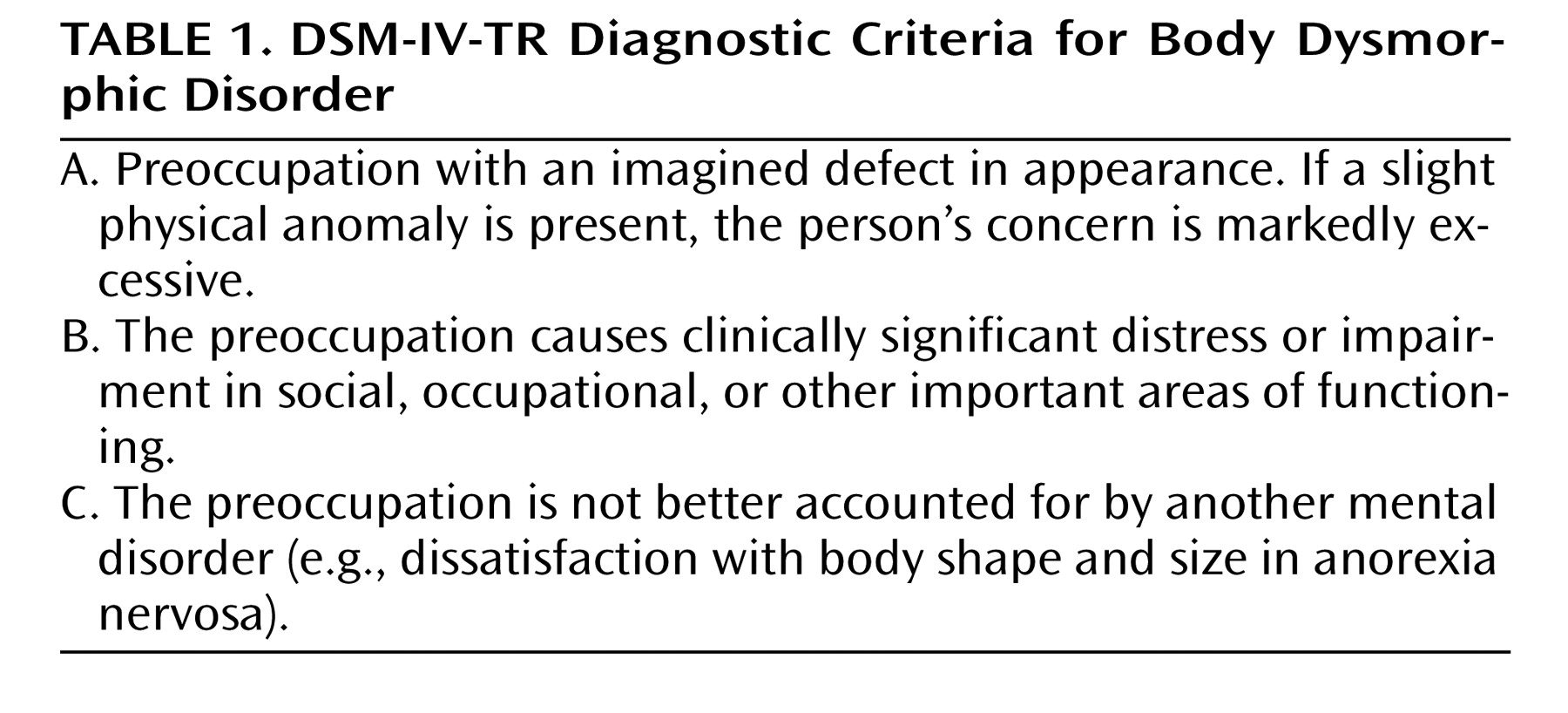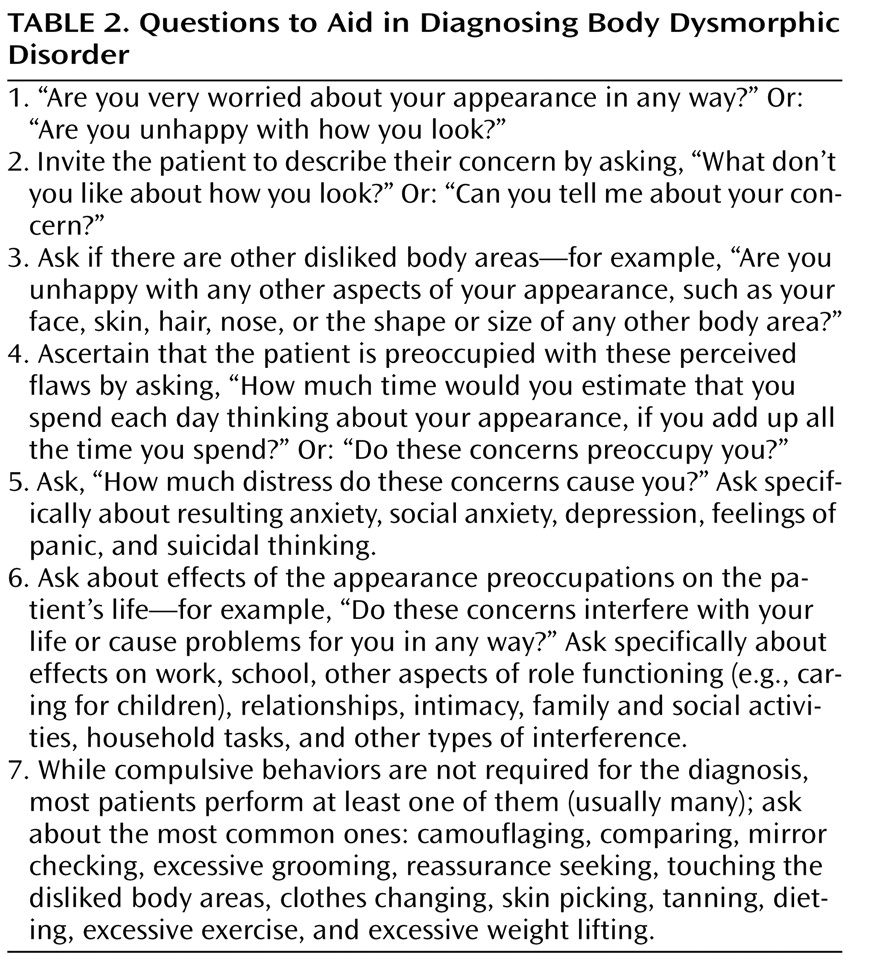Treatment began with psychoeducation about body dysmorphic disorder and its treatment, both in sessions with Mr. H and by recommending reading on the disorder. We noted that people with body dysmorphic disorder see themselves differently than other people do, but we did not focus on Mr. H’s appearance or try to talk him out of his view of how he looked. Instead, we focused on his intense suffering, preoccupation, difficulty functioning, and the potential for treatment to improve his life. Mr. H agreed that telling his girlfriend about his body dysmorphic disorder would give him much-needed support and help reduce his feelings of isolation. During our first meeting, we discussed the options of CBT and medication. No studies have directly compared the efficacy of these treatments or examined whether combined CBT and pharmacotherapy is superior to either treatment alone. Mr. H preferred to start treatment with medication, as he thought this approach would require less effort and fewer appointments than CBT. It is unclear whether some SRIs are more efficacious than others, as no head-to-head comparison studies have been done. Mr. H preferred a medication shown to be efficacious in a controlled study, so we chose fluoxetine. Even though Mr. H’s appearance beliefs were delusional, we started treatment with SRI monotherapy. We initially prescribed 20 mg/day. The most tolerable dosing strategy, in our experience, is to start with a low dose and gradually titrate the dose upward while monitoring for side effects. After 2 weeks, we raised his dose to 40 mg/day, and after another 2 weeks, we raised it to 60 mg/day, as Mr. H had shown no signs of improvement and was tolerating the medication well. We used this titration schedule because it appears that many patients require at least 60 mg/day of fluoxetine, and we wanted to avoid a protracted trial. Dose-finding studies have not been conducted, but clinical experience suggests that higher doses are often needed to treat body dysmorphic disorder than are typically used for major depression. Our usual approach is to reach the maximum SRI dose recommended by the manufacturer within 5 to 9 weeks of starting treatment, unless this dose is not tolerated or a lower dose is effective. Patients who have difficulty tolerating side effects or have a robust and early response may benefit from remaining at a lower dose for a longer time to determine whether an additional dose increase seems warranted. After 6 weeks of treatment, Mr. H began to notice some improvement; he felt less self-conscious, his intrusive thoughts began to diminish, his compulsive behaviors became less frequent and easier to resist, and his insight, referential thinking, depressive symptoms, functioning, and suicidal ideation started to improve. After 8 weeks of treatment, and while taking 60 mg/day, his symptoms had improved by 30% on the Yale-Brown Obsessive Compulsive Scale Modified for Body Dysmorphic Disorder. At that point, we raised the fluoxetine dosage to 80 mg/day, as he was tolerating the medication well and still had symptoms. In our clinical experience, daily doses even higher than 80 mg of fluoxetine or its equivalent can be used if necessary (except for clomipramine), given these medications’ high therapeutic index. While Mr. H had a clinically meaningful response after 8 weeks, some patients need SRI treatment for as long as 14 weeks, with titration to a relatively high dose, before their symptoms significantly improve. The mean time to SRI response in published studies, in which fairly rapid titration schedules were used, ranges from about 4 to 9 weeks
(30,
33 –
35 ). After Mr. H had taken fluoxetine for 14 weeks (6 weeks at 80 mg/day), his score on the modified Yale-Brown scale had decreased by 35% from baseline. While substantially improved, he was still distressed over his appearance and experiencing some functional impairment. We discussed next-step options: further raising his fluoxetine dose, augmenting fluoxetine with another medication, or CBT. Mr. H preferred CBT—by now he was motivated and eager to learn skills to reduce his remaining symptoms. For patients who are not motivated enough to do CBT, motivational interviewing techniques may be helpful. For those who are too severely ill or depressed to participate in CBT, an SRI may improve symptoms to the point where CBT is more feasible. While continuing fluoxetine at 80 mg/day, we initiated CBT treatment. The treatment followed a treatment manual
(26) and consisted of 22 weekly 60-minute sessions. Together, the therapist and Mr. H developed an initial conceptualization of why Mr. H’s symptoms might have developed and which thoughts and behaviors maintained them. They discovered, for example, that Mr. H often assumed that other people reacted negatively to him because of his appearance flaws. This made him very anxious and depressed. To avoid these unpleasant feelings, Mr. H engaged in rituals and avoided social situations and sometimes work. This case conceptualization guided the therapy. The therapist provided education about body dysmorphic disorder from a CBT perspective, highlighting how rituals and avoidance behaviors reinforce and maintain body-dysmorphic preoccupations and maladaptive thinking. Mr. H and his therapist identified goals for treatment, which included changing the self-defeating ways in which Mr. H thought about his appearance, decreasing maladaptive behaviors (such as rituals and avoidance of work and social situations), and increasing adaptive behaviors (such as socializing, developing hobbies, and consistently going to work). Mr. H then learned to identify and modify his self-defeating thoughts. For example, while at work Mr. H had the thought, “That lady looks so upset. She must be noticing how ugly my skin is.” His therapist encouraged Mr. H to evaluate the evidence for and against this particular thought. Mr. H learned to write his thoughts in a thought record and to respond to them with a rational response, such as “It’s much more likely that the woman was upset because she couldn’t find what she was looking for, not because she was disgusted by my skin.” Over time, he became skilled at modifying his self-defeating thoughts, which in turn diminished his anxiety, depression, and shame. Over the course of treatment it became apparent that Mr. H’s negative assumptions about how others would respond to him were based on deeper distorted core beliefs—that is, global, overgeneralized ideas about himself or the world. For Mr. H, the core beliefs “I’m unlovable” and “I’m inadequate” seemed to maintain his body-dysmorphic thoughts and behaviors. Later in treatment, cognitive restructuring and other approaches targeted these deeper-level irrational beliefs. As Mr. H developed proficiency in evaluating and modifying his negative thoughts, his therapist introduced exposure and response (ritual) prevention techniques. Exposure and response prevention were usually combined, and over time Mr. H (guided by his therapist) worked on increasingly more challenging situations. For example, he started by visiting his relatives at home without wearing his hat (exposure) and refraining from going into the bathroom to check his hair and skin in the mirror during their visit (response prevention). As a next step, he worked on not wearing his hat and refraining from mirror checking when going out on a walk with his girlfriend. Later in treatment he completed the same exercise in increasingly crowded social situations (e.g., restaurants, work, and shopping malls). Mr. H also gradually cut down on and eventually stopped his other compulsive behaviors, which included learning habit reversal to stop his skin picking. Mr. H also learned to design and conduct behavioral experiments to test his body-dysmorphic beliefs (e.g., that people were laughing at him) and to determine whether they were accurate. Behavioral experiments were combined with exposure and cognitive restructuring. A perceptual retraining exercise helped Mr. H learn to look in the mirror and describe his entire body rather than selectively focusing only on disliked areas. Mr. H learned to refrain from critical self-talk while looking in the mirror and to use more objective descriptions of his appearance—for example, saying, “My eyes are brown” rather than “My hair is ugly and should be thicker.” Mr. H was also encouraged not to perform any rituals, such as compulsively checking his appearance or picking his skin, while completing this exercise. In addition to working on these strategies during his treatment sessions, Mr. H spent 40–60 minutes a day practicing them between sessions. The two final treatment sessions focused on relapse prevention and prepared Mr. H for the period after treatment ended. For example, unrealistic expectations, such as “I’ll never have any body dysmorphic disorder symptoms again,” were discussed. He made a coping plan with his therapist that outlined what he should do if symptoms recurred (e.g., restarting thought records and doing exposure, response prevention, and behavioral experiments). Overall, Mr. H benefited greatly from treatment. After 22 CBT sessions, and while taking 80 mg/day of fluoxetine, his score on the modified Yale-Brown scale was only 6. He spent about 20 minutes a day thinking about his appearance and performing compulsive behaviors. His appearance-related thoughts were more accurate and caused only mild distress. In addition, Mr. H no longer avoided situations or had any impairment in functioning. He went to work regularly, performed his job well, attended family events, and socialized more frequently. His mood, insight, and delusions of reference improved, and he no longer had any suicidal thinking.



